Structure and Magnetic Properties of Bulk Synthesized Mn2−xFexP1−ySiy Compounds from Magnetization, 57Fe Mössbauer Spectroscopy, and Electronic Structure Calculations
Abstract
1. Introduction
- -
- A local structure distortion index which can affect the tetrahedral site in which the sensitive Fe-metal (weak-ferro versus strong-ferro character), possibly linking the magnetic correlations with magnetoelastic couplings;
- -
- Optimized route to process intermetallic materials, comprising amounts of phosphorous, easily and safely, to deliver bulk samples with high magnetocaloric performances;
- -
- Better understanding the magnetic properties from correlated Mössbauer spectroscopy and electronic structure calculations.
2. Materials and Methods: On Synthesis Routes
3. Results
3.1. Structure Analysis
3.1.1. Structure Characterization at Room Temperature
3.1.2. Structure Characterization versus Temperature
3.1.3. Local Structure Distortion Index and Magnetic Polarization
3.2. Magnetization Properties and MCE Characteristics of Bulk Synthesized Mn2−xFexP1−ySiy Compounds
3.2.1. Tc Determination and Isothermal Magnetization Measurements
3.2.2. MCE Characterizations
3.3. 57Fe Mössbauer Spectroscopy Analysis
3.3.1. Results
3.3.2. Data Analysis
3.4. Electronic Structure Analysis
3.4.1. Computational Details
3.4.2. Site Preference
- (i)
- 0.9 Fe and 0.1 Mn on 3f, 0.5 Fe and 0.5 Mn on 3g;
- (ii)
- 1.0 Fe on 3f, 0.4 Fe and 0.6 Mn on 3g;
- (iii)
- fully random distribution of TM elements, i.e., 0.5 Fe and 0.5 Mn on 3f and 3g sites.
- (i)
- 0.75 P and 0.25 Si on 2c, 1.0 Si on 1b;
- (ii)
- 0.25 P and 0.75 Si on 2c, 1.0 P on 1b;
- (iii)
- fully random distribution of both metalloids, i.e., 0.5 P and 0.5 Si on 2c and 1b sites.
3.4.3. Magnetic Properties of Mn2−xFexP1−ySiy
4. Conclusions and Perspectives
Author Contributions
Funding
Conflicts of Interest
Appendix A

| Interatomic Distances at 290 K [Å] | ||
|---|---|---|
| MnFeP0.5Si0.5 | Mn0.6Fe1.4P0.6Si0.4 | |
| Mn-Mn | 3.267 x4 | 3.233 x4 |
| Mn-Fe | 2.716 x2 2.740 x4 | 2.619 x2 2.737 x2 |
| Mn-P,Si Mn-P | 2.509 x4 2.499 x1 | 2.503 x4 2.461 x1 |
| Fe-P,Si Fe-P | 2.371 x2 2.267 x2 | 2.268 x2 2.339 x2 |
| Fe-Fe | 2.673 x2 | 2.642 x2 |
| 300 K (F) | 465 K (P) | |
|---|---|---|
| Mn-Mn | 3.262 x4 | 3.203 x4 |
| Mn-Fe | 2.691 x2 2.758 x4 | 2.689 x2 2.763 x4 |
| Mn-P | 2.505 x2 2.505 x2 2.528 x1 | 2.533 x2 2.534 x2 2.455 x1 |
| Fe-P | 2.371 x2 2.267 x2 | 2.291 x2 2.335 x2 |
| Fe-Fe | 2.689 x2 | 2.712 x2 |
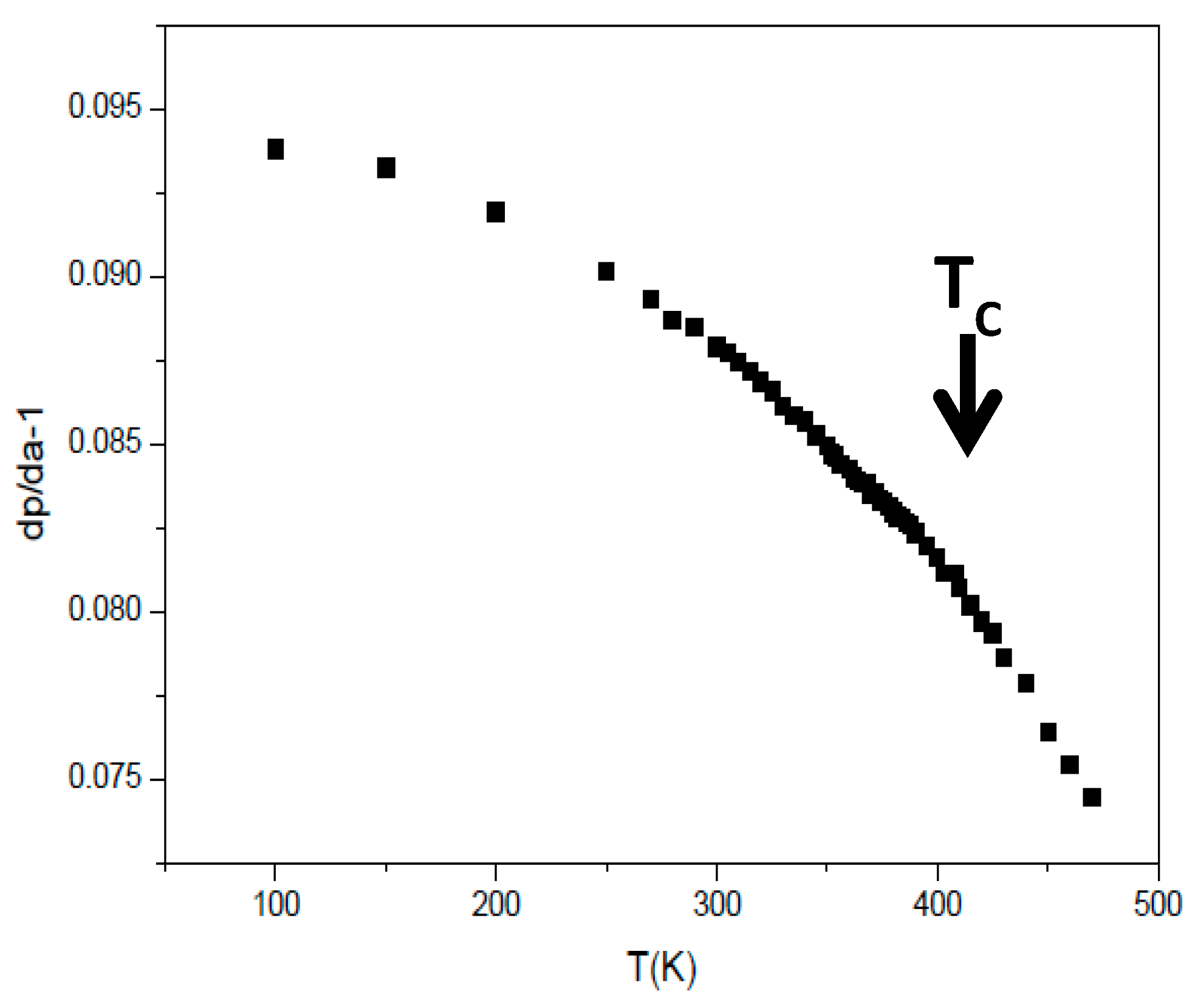
References
- Fruchart, R. Effets d’électronégativité et interactions métalliques dans les phosphures et arséniures ternaires des éléments de transition 3d, 4d, 5d de type métallique. Annales de Chimie 1982, 7, 563–604. (In French) [Google Scholar]
- Beckman, O.; Lundgren, L. Compounds of transition elements with nonmetals. Hand. Magn. Mater. 1991, 6, 181–287. [Google Scholar]
- Fruchart, D.; Wolfers, P. Chalcogenides and Pnictides. In Handbook of Magnetic and Advanced Magnetic Materials (HMM); Krönmuller, H., Parkin, S., Eds.; J. Wiley and Sons: Hoboken, NJ, USA, 2007; pp. 2378–2400. [Google Scholar]
- Krumbuguel-Nylund, A. Etude Structurale et Magnétique des Arséniophosphures MM4(P1−yAsy) et des Solutions Solides Entre Arséniures M2As des Métaux de Transitions de la Première Série (M,M’ = Cr, Mn, Fe, Co, Ni). Ph.D. Thesis, Université Paris-Orsay, Orsay, France, 1974. (In French). [Google Scholar]
- Yoshii, S.; Katsuraki, H. Neutron Diffraction Study of FeMnAs. J. Phys. Soc. Japan 1967, 22, 674. [Google Scholar] [CrossRef]
- Roger, A. Etude Cristallographique et Magnétique des Phosphures MP et M2P de la Série du fer et de Leurs Solutions Solides. Ph.D. Thesis, Université de Paris, Paris, France, 1970. (In French). [Google Scholar]
- Chenevier, B. Etude des Transitions de Phases Cristallines et Magnétiques Dans les Systèmes Fe2P-Mn2P, MnRuAs, MnRhAs et FeRhP. Ph.D. Thesis, Université J. Fourier, Grenoble, France, 1990. (In French). [Google Scholar]
- Suzuki, T.; Yamaguchi, Y.; Yamamoto, H.; Watanabe, H. Magnetic Structure of FeMnP. J. Phys. Soc. Jpn. 1973, 34, 911–916. [Google Scholar] [CrossRef]
- Chenevier, B.; Soubeyroux, J.L.; Bacmann, M.; Fruchart, D.; Fruchart, R. The high temperature orthorhombic-hexagonal phase transformation of FeMnP. Sol. State Commun. 1987, 64, 57–61. [Google Scholar] [CrossRef]
- Tobola, J.; Bacmann, M.; Fruchart, D.; Wolfers, P.; Kaprzyk, S.; Koumina, A.A. Structure and magnetism in the polymorphous MnFeAs. J. Alloys Compd. 2001, 317, 274–279. [Google Scholar] [CrossRef]
- Senateur, J.P.; Rouault, A.; Fruchart, R.; Capponi, J.J.; Perroux, M. Etude par spectrométrie Mössbauer des transformations cristallographiques sous hautes pressions de MnFeAs et Fe2P. Mat. Res. Bull. 1976, 11, 631–635. (In French) [Google Scholar] [CrossRef]
- Roy, P. Treatise on Magnetocaloric MnFe(Si,P) Compounds: A First-Principles Study. Ph.D. Thesis, Radboud University, Nijmegen, The Netherlands, 2016. [Google Scholar]
- Sénateur, J.P.; Fruchart, D.; Boursier, D.; Rouault, A.; Montreuil, J.R.; Deyris, B. Analyse des facteurs d’ordre des matériaux de transition dans les phosphures et arséniures MM’P et MM’As. J. Phys. Coll. 1977, 38, 61–70. (In French) [Google Scholar]
- Bacmann, M.; Soubeyroux, J.L.; Barrett, R.; Fruchart, D.; Zach, R.; Niziol, S.; Fruchart, R. Magnetoelastic transition and antiferro-ferromagnetic ordering in the system MnFeP1−yAsy. J. Magn. Magn. Mater. 1994, 134, 59–67. [Google Scholar] [CrossRef]
- Malaman, B.; Le Caër, G.; Delcroix, P.; Fruchart, D.; Bacmann, M.; Fruchart, R. Magneto-elastic transition and magnetic couplings: A Mössbauer spectroscopy study of the system. J. Phys. Cond. Matter 1996, 8, 8653. [Google Scholar] [CrossRef]
- Zach, R.; Niziol, S.; Karpzyk, S.; Tobola, J.; Bacmann, M.; Fruchart, D.; Fruchart, R.; Wolfers, P. Magnetoelastic properties of MnFeP1−yAsy and band structure results from KKR-CPA. Acta Phys. Pol. 1997, A91, 471–477. [Google Scholar] [CrossRef]
- Hermann, R.P.; Tegus, O.; Brück, E.; Buschow, K.H.J.; De Boer, F.R.; Long, G.J.; Grandjean, F. Mössbauer spectral study of the magnetocaloric FeMnP1−xAsx compounds. Phys. Rev. B 2004, 70, 214425. [Google Scholar] [CrossRef]
- Sénateur, J.P.; Madar, R.; Fruchart, R.; Fruchart, D.; Auric, P. Interpretation of the ambiguous Mössbauer spectra of Fe2P: Study of a 57Co/Fe2P source. In Proceedings of the VI International Conference on Solid Compounds of Transition Elements, Stuttgart, Germany, 12–16 June 1979; pp. 88–191. [Google Scholar]
- Ericsson, T.; Häggström, L.; Wäppling, R.; Methasiri, T. Mössbauer spectroscopic study of Fe2P with Cu impurities. Phys. Scripta 1980, 21, 212. [Google Scholar] [CrossRef]
- Wiendlocha, B.; Tobola, J.; Kaprzyk, S.; Zach, R.; Hlil, E.K.; Fruchart, D. Magnetocaloric properties of Fe2−xTxP (T = Ru and Rh) from electronic structure calculations and magnetization measurements. J. Phys. D Appl. Phys. 2008, 41, 205007. [Google Scholar] [CrossRef]
- Tobola, J. Study of Intermetallic Compounds Containing Iron by Band Theory Methods. Ph.D. Thesis, AGH Krakow, Kraków, Poland, 1994. [Google Scholar]
- Moriya, T. Spin fluctuations in ferromagnetic metals—Temperature variation of local moment and short-range order. J. Phys. Soc. Japan 1982, 51, 420–434. [Google Scholar] [CrossRef]
- Miao, X.F.; Caron, L.; Gubbens, P.C.M.; Yaouanc, A.; de Réotier, P.D.; Luetkens, H.; Brück, E. Spin correlations in (Mn,Fe)2(P,Si) magnetocaloric compounds above Curie temperature. J. Sci. Adv. Mater. Devices 2016, 1, 147–151. [Google Scholar] [CrossRef]
- Haj-Khlifa, S.; de Rango, P.; Fruchart, D.; Zach, R. Crystal and magnetic effects of selected substitutions of Ni for Fe and for Co in the orthorhombic MnFe0.35Co0.65P compound. J. Alloys Compd. 2015, 652, 322–330. [Google Scholar] [CrossRef]
- Tegus, O.; Brück, E.; Buschow, K.H.J.; de Boer, F.R. Transition-metal-based magnetic refrigerants for room-temperature applications. Nature 2002, 415, 150. [Google Scholar] [CrossRef]
- Tegus, O.; Brück, E.; Zhang, L.; Buschow, K.H.J.; de Boer, F.R. Magnetic-phase transitions and magnetocaloric effects. Phys. B Cond. Matter 2002, 319, 174–192. [Google Scholar] [CrossRef]
- Koyama, K.; Kanomata, T.; Watanabe, K. High field X-ray diffraction studies on MnFeP0.5As0.5. Japan. J. Appl. Phys. 2005, 44, L549. [Google Scholar] [CrossRef]
- Yue, M.; Li, Z.Q.; Wang, X.L.; Liu, D.M.; Zhang, J.X.; Liu, X.B. Crystal structure and magnetic transition of MnFePGe compound prepared by spark plasma sintering. J. Appl. Phys. 2009, 105, 7A915. [Google Scholar] [CrossRef]
- Yibole, H.; Guillou, F.; Huang, Y.K.; Blake, G.R.; Lefering, A.J.E.; van Dijk, N.H.; Brück, E. First-order ferromagnetic transition in single-crystalline (Mn,Fe)2(P,Si). Appl. Phys. Lett. 2015, 107, 162403. [Google Scholar] [CrossRef]
- Höglin, V.; Hudl, M.; Caron, L.; Beran, P.; Sørby, M.H.; Nordblad, P.; Sahlberg, M. Detailed study of the magnetic ordering in FeMnP0.75Si0.25. J. Solid State Chem. 2015, 221, 240–246. [Google Scholar] [CrossRef]
- Guillou, F.; Ollefs, K.; Wilhelm, F.; Rogalev, A.; Yaresko, A.N.; Yibole, H.; Brück, E. Electronic and magnetic properties of phosphorus across the first-order ferromagnetic transition of (Mn,Fe)2(P, Si, B) giant magnetocaloric materials. Phys. Rev. B 2015, 92, 224427. [Google Scholar] [CrossRef]
- Delczeg-Czirjak, E.K.; Pereiro, M.; Bergqvist, L.; Kvashnin, Y.O.; Di Marco, I.; Li, G.; Eriksson, O. Origin of the magnetostructural coupling in FeMnP0.75Si0.25. Phys. Rev. B 2014, 90, 214436. [Google Scholar] [CrossRef]
- Okamoto, H. The Iron Phosphorus (Fe-P) System. ASM Int. Bull. Alloy Diagr. 1990, 11, 4. [Google Scholar] [CrossRef]
- Sandeman, K.G. Magnetocaloric materials: The search for new systems. Scripta Mater. 2012, 67, 566–571. [Google Scholar] [CrossRef]
- Mayer, C.; Pierronnet, M. (Erasteel SAS, 33 avenue du Maine, 75755 Paris Cedex 15, France). Private communication, 2014.
- Khadechi-Haj Khlifa, S. Propriétés Structurales, Magnétiques et Magnétocaloriques de Pnictures Isotypes de Mn (Fe, Co) P. Ph.D. Thesis, Université Grenoble Alpes, Grenoble, France, 2016. (In French). [Google Scholar]
- Luo, J. (Xian PureMetals Advanced Materials Ltd., 40-3-502 Erfuzhuang Zone Zhengfa Xiang, Weiyang Road, Xian City, Shaanxi Province 720016, China). Personal communication, 2018.
- Meisner, G.P. The Superconductivity, Structure, and Magnetism of Some Ternary Transition Metal Phosphides and Arsenides. Ph.D. Thesis, University of California, San Diego, CA, USA, 1983. [Google Scholar]
- Boeije, M.F.J.; Maschek, M.; Miao, X.F.; Thang, N.V.; van Dijk, N.H.; Brück, E. Mixed magnetism in magnetocaloric materials with first-order and second-order magnetoelastic transitions. J. Phys. D Appl. Phys. 2017, 50, 174002. [Google Scholar] [CrossRef]
- Wurentuya, B.; Yibole, H.; Guillou, F.; Ou, Z.; Zhang, Z.; Tegus, O. First-order magnetic transition, magnetocaloric effect and moment formation in MnFe(P,Ge) magnetocaloric materials revisited by x-ray magnetic circular dichroism. Phys. B. Cond. Matter 2018, 544, 66–72. [Google Scholar] [CrossRef]
- Cam Thanh, T.; Brück, E.; Trung, N.T.; Klaasse, J.C.P.; Buschow, K.H.J.; Ou, Z.Q.; Tegus, O.; Caron, L. Structure, magnetism, and magnetocaloric properties of MnFeP1−xSix compounds. J. Appl. Phys. 2008, 103, 7B318. [Google Scholar] [CrossRef]
- Hudl, M.; Häggström, L.; Delczeg-Czirjak, E.K.; Höglin, V.; Sahlberg, M.; Vitos, L.; Eriksson, O.; Nordblad, P.; Andersson, Y. Strongly enhanced magnetic moments in ferromagnetic FeMnP0.5Si0.5. Appl. Phys. Lett. 2011, 99, 152502. [Google Scholar] [CrossRef]
- Dung, N.H.; Zhang, L.; Ou, Z.Q.; Brück, E. Magneto-elastic coupling and magnetocaloric effect in hexagonal Mn-Fe-P-Si compounds. Scripta Mater. 2012, 67, 975–978. [Google Scholar] [CrossRef]
- Dung, N.H.; Zhang, L.; Ou, Z.Q.; Zhao, L.; van Eijck, L.; Mulders, A.M.; Avdeev, M.; Suard, E.; van Dijk, N.H.; Bruck, E. High/low-moment phase transition in hexagonal Mn-Fe-P-Si compounds. Phys. Rev. B 2012, 86, 045134. [Google Scholar] [CrossRef]
- Höglin, V.; Cedervall, J.; Andersson, M.S.; Sarkar, T.; Nordblad, P.; Sahlberg, M. Irreversible structure change of the as prepared FeMnP1−xSix structure on the initial cooling through the Curie Temperature. J. Magn. Magn. Mater. 2015, 374, 455–458. [Google Scholar]
- Christiaanse, T.V.; Campbell, O.; Trevizoli, P.V.; Misra, S.; van Asten, D.; Zhang, L.; Govindappa, P.; Niknia, I.; Teyber, R.; Rowe, A. A concise approach for building the s-T diagram for Mn-Fe-P-Si hysteretic magnetocaloric material. J. Phys. D Appl. Phys. 2017, 50, 365001. [Google Scholar] [CrossRef]
- Fries, M.; Pfeuffer, L.; Bruder, E.; Gottschall, T.; Ener, S.; Diop Lé, V.B.; Gröb, T.; Skokov, K.P.; Gutfleisch, O. Microstructural and magnetic properties of Mn-Fe-P-Si (Fe2P-type) magnetocaloric compounds. Acta Mater. 2017, 132, 222–229. [Google Scholar] [CrossRef]
- He, A.; Svitlyk, V.; Mozharivskyj, Y. Synthetic Approach for (Mn,Fe)2(Si,P) Magnetocaloric Materials: Purity, Structural, Magnetic, and Magnetocaloric Properties. Inorg. Chem. 2017, 56, 2827–2833. [Google Scholar] [CrossRef]
- Miao, X.F.; Hu, S.Y.; Xu, F.; Ekkes Bruck, E. Overview of magnetoelastic coupling in (Mn, Fe)2(P,Si)-type magnetocaloric materials. Rare Metals 2018, 37, 723–733. [Google Scholar] [CrossRef]
- Balli, M.; Fruchart, D.; Zach, R. Negative and conventional magnetocaloric effects of a MnRhAs single crystal. J. Appl. Phys. 2014, 115, 203909. [Google Scholar] [CrossRef]
- Balli, M.; Jandl, S.; Fournier, P.; Kedous-Lebouc, A. Advanced materials for magnetic cooling: Fundamentals and practical aspects. Appl. Phys. Rev. 2017, 4, 021305. [Google Scholar] [CrossRef]
- Pecharsky, V.K.; Gschneidner, K.A., Jr. Magnetocaloric effect from indirect measurements: Magnetization and heat capacity. J. Appl. Phys. 1999, 86, 565–575. [Google Scholar] [CrossRef]
- Rosca, M. Matériaux de Type LaFe13−xSix à Fort Pouvoir Magnétocalorique-Synthèse et Optimisation de Composés Massifs et Hypertrempés—Caractérisations Fondamentales. Ph.D. Thesis, Université de Grenoble, Grenoble, France, 2010. (In French). [Google Scholar]
- Zach, R.; Tobola, J.; Sredniawa, B.; Kaprzyk, S.; Guillot, M.; Fruchart, D.; Wolfers, P. Magnetic interactions in the MnFe1−xCoxP series of solid solutions. J. Phys. Cond. Matter 2007, 19, 376201. [Google Scholar] [CrossRef]
- Średniawa, B.; Zach, R.; Fornal, P.; Duraj, R.; Bombik, A.; Tobola, J.; Fruchart, D. Crystal structure, magnetic and electronic properties of CoxFe1−xMnP system. J. Alloys Compd. 2001, 317, 266–273. [Google Scholar] [CrossRef]
- Zach, R.; Tobola, J.; Chajec, W.; Fruchart, D.; Ono, F. Magnetic properties of MM’X (M = Mn, M’ = 3d or 4d metal, X = P, As, Si, Ge) compounds with hexagonal or orthorhombic crystal structure. Sol. State Phenom. 2013, 194, 98–103. [Google Scholar] [CrossRef]
- Zach, R. Magnetic Properties and Magnetoelastic Phase Transitions of MnFeP1−xAsx (0.15 < x < 0.66) and MnRhP1−xAsx Isostructural Series of Solid Solutions. Habilitation Thesis, Zeszyty Naukowe Politechnika Krakowska, Kraków, Poland, 1997. [Google Scholar]
- Mitsiuk, V.I.; Tkachenka, T.M.; Budzynski, M.; Surowiec, Z.; Valkov, V.I. Mössbauer investigations of Mn2−xFexP0.5As0.5. Nukleonika 2013, 58, 169–172. [Google Scholar]
- Dubiel, S.M. Relationship between the magnetic hyperfine field and the magnetic moment. J. Alloys Compd. 2009, 488, 18–22. [Google Scholar] [CrossRef]
- Tobola, J.; Bacmann, M.; Fruchart, D.; Kaprzyk, S.; Koumina, A.; Niziol, S.; Zach, R. Magnetism of Fe2P investigated by neutron experiments and band structure calculations. J. Mag. Mag. Mat. 1996, 157, 708–710. [Google Scholar] [CrossRef]
- Kaprzyk, S.; Niziol, S.; Tobola, J.; Zach, R.; Bacmann, M.; Fruchart, D.; Wolfers, P. Magnetic and transport properties of (Fe1−xNix)2P in view of KKR-CPA results. Acta Phys. Pol. A 1997, 91, 475. [Google Scholar] [CrossRef]
- Tobola, J.; Kapryzk, S.; Fruchart, D.; Bacmann, M.; Wolfers, P.; Fruchart, R. Electronic and magnetic structure of ternary transition metal arsenides related to the Fe2X type (X = P, As). J. Alloys Compd. 1997, 262, 65–70. [Google Scholar] [CrossRef]
- Zach, R.; Bacmann, M.; Fruchart, D.; Wolfers, P.; Fruchart, R.; Guillot, M.; Tobola, J. Magneto-elastic properties of MnFeP1−xAsx (0.15 ≤ x ≤ 0.66) and MnRhP1−xAsx isostructural series of compounds. J. Alloys Compd. 1997, 262, 508–511. [Google Scholar] [CrossRef]
- Zach, R.; Guillot, M.; Tobola, J. Semiquantitative analysis of magnetic phase transitions in the MnFeP1−xAsx series of compounds. J. Appl. Phys. 1998, 83, 7237–7239. [Google Scholar] [CrossRef]
- Sredniawa, B.; Zach, R.; Fornal, P.; Duraj, R.; Bombik, A.; Tobola, J.; Kaprzyk, S.; Nizioł, S.; Fruchart, D.; Bacmann, M.; et al. Crystal structure, magnetic properties of Co(Mn-Fe)P system. J. Alloys Compd. 2001, 317–318, 218–223. [Google Scholar]
- Sredniawa, B.; Zach, R.; Chajec, W.; Duraj, R.; Tobola, J.; Niziol, S.; Fruchart, D.; Bacmann, M. Magnetism and electronic structure of the (Co1−xMnx)2P system. J. Magn. Mag. Mat. 2002, 242, 931–934. [Google Scholar] [CrossRef]
- Zach, R.; Tobola, J.; Sredniawa, B.; Kaprzyk, S.; Casado, C.; Bacmann, M.; Fruchart, D. Magneto-elastic properties and electronic structure analysis of the (Fe1−xNix)2P system. J. Alloys Compd. 2004, 383, 322–327. [Google Scholar] [CrossRef]
- Fruchart, D.; Allab, F.; Balli, M.; Gignoux, D.; Hlil, E.K.; Koumina, A.; Zach, R. On the magnetocaloric effect in d-metal pnictides. Phys. A Statist. Mech. Appl. 2005, 358, 123–135. [Google Scholar] [CrossRef]
- Balli, M.; Fruchart, D.; Gignoux, D.; Tobola, J.; Hlil, E.K.; Wolfers, P.; Zach, R. Magnetocaloric effect in ternary metal phosphides (Fe1−xNix)2P. J. Magn. Magn. Mat. 2007, 316, 358–360. [Google Scholar] [CrossRef]
- Zach, R.; Fukami, Y.; Tobola, J.; Ono, F.; Fruchart, D. Pressure induced state in the orthorhombic (Mn1−xCox)2P system. J. Phys. Cond. Matter 2008, 20, 195207. [Google Scholar] [CrossRef]
- Zach, R.; Chajec, W.; Tobola, J.; Fruchart, D.; Hlil, E.K.; Balli, M.; Wolfers, P. Magnetic properties and magnetocaloric effect in selected MM’X-type (M, M’ = 3d or 4d metal, X = As, P, Ge) and Mn1−xTxAs-type (T = 3d metal) intermetallics. Sol. State Phenom. 2011, 170, 180–184. [Google Scholar] [CrossRef]
- Szymański, D.; Zach, R.; Chajec, W.; Duraj, R.; Tobola, J.; Guillot, M.; Fruchart, D. Magnetization, high pressure, and magnetocaloric studies of MnRuxRh1−xAs (x = 0.05, 0.1): Experimental and theoretical approaches. J. Alloys Compd. 2018, 776, 59–70. [Google Scholar]
- Butler, W.H.; Dederichs, P.H.; Gonis, A.; Weaver, R.L. Application of Multiple Scattering Theory to Materials Science: Volume 253 (MRS Proceedings); Materials Research Society: Pittsburgh, PA, USA, 1992. [Google Scholar]
- Der Kellen, S.B.; Oh, Y.; Badralexe, E.; Freeman, A.J. Self-consistent full-potential total-energy Korringa-Kohn-Rostoker band-structure method: Application to silicon. Phys. Rev. B 1995, 51, 9560. [Google Scholar] [CrossRef]
- Stopa, T.; Kaprzyk, S.; Toboła, J. Linear aspects of the Korringa–Kohn–Rostoker formalism. J. Phys. Cond. Matter 2004, 16, 4921. [Google Scholar] [CrossRef]
- Perdew, J.P.; Wang, Y. Accurate and simple analytic representation of the electron-gas correlation energy. Phys. Rev. B 1992, 45, 13244. [Google Scholar] [CrossRef]
- Kaprzyk, S.; Bansil, A. Green’s function and a generalized Lloyd formula for the density of states in disordered muffin-tin alloys. Phys. Rev. B 1990, 42, 7358. [Google Scholar] [CrossRef]
- Bansil, A.; Kaprzyk, S.; Mijnarends, P.E.; Tobola, J. Electronic structure and magnetism of Fe3−xVxX (X = Si, Ga, and Al) alloys by the KKR-CPA method. Phys. Rev. B 1999, 60, 13396. [Google Scholar] [CrossRef]
- Niziol, S.; Bombik, A.; Bazela, W.; Szytula, A.; Fruchart, D. Crystal and magnetic structure of CoxNi1−xMnGe system. J. Magn. Magn. Mater. 1982, 27, 281–292. [Google Scholar] [CrossRef]
- Niziol, S.; Binczycka, H.; Szytula, A.; Todorovic, J.; Fruchart, R.; Senateur, J.P.; Fruchart, D. Structure magnétique des MnCoSi. Phys. Stat. Solidi (a) 1978, 45, 591–597. [Google Scholar] [CrossRef]
- Balli, M.; Fruchart, D.; Gignoux, D.; Zach, R. The “colossal” magnetocaloric effect in Mn1−xFexAs: What are we really measuring? Appl. Phys. Lett. 2009, 95, 072509. [Google Scholar] [CrossRef]
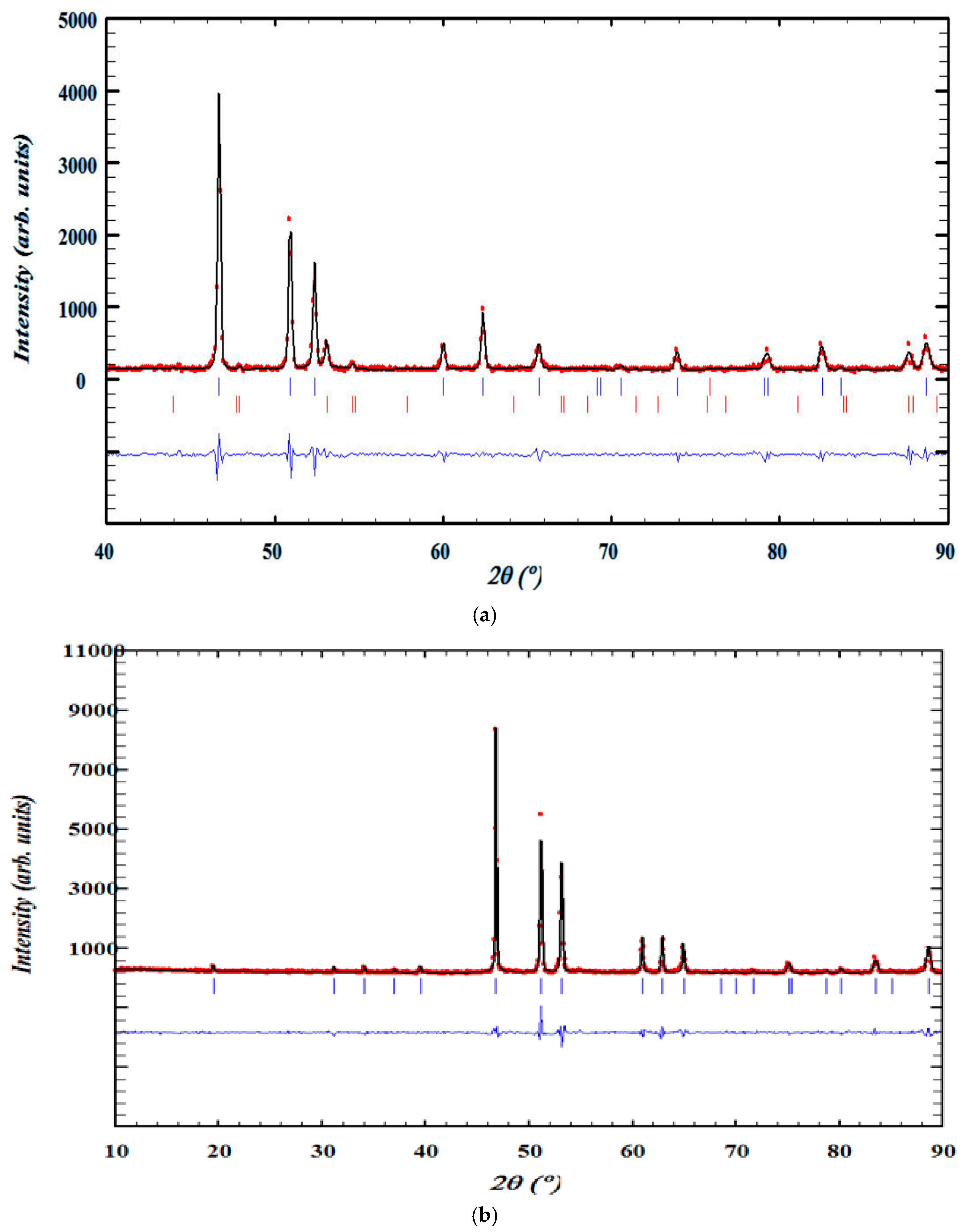
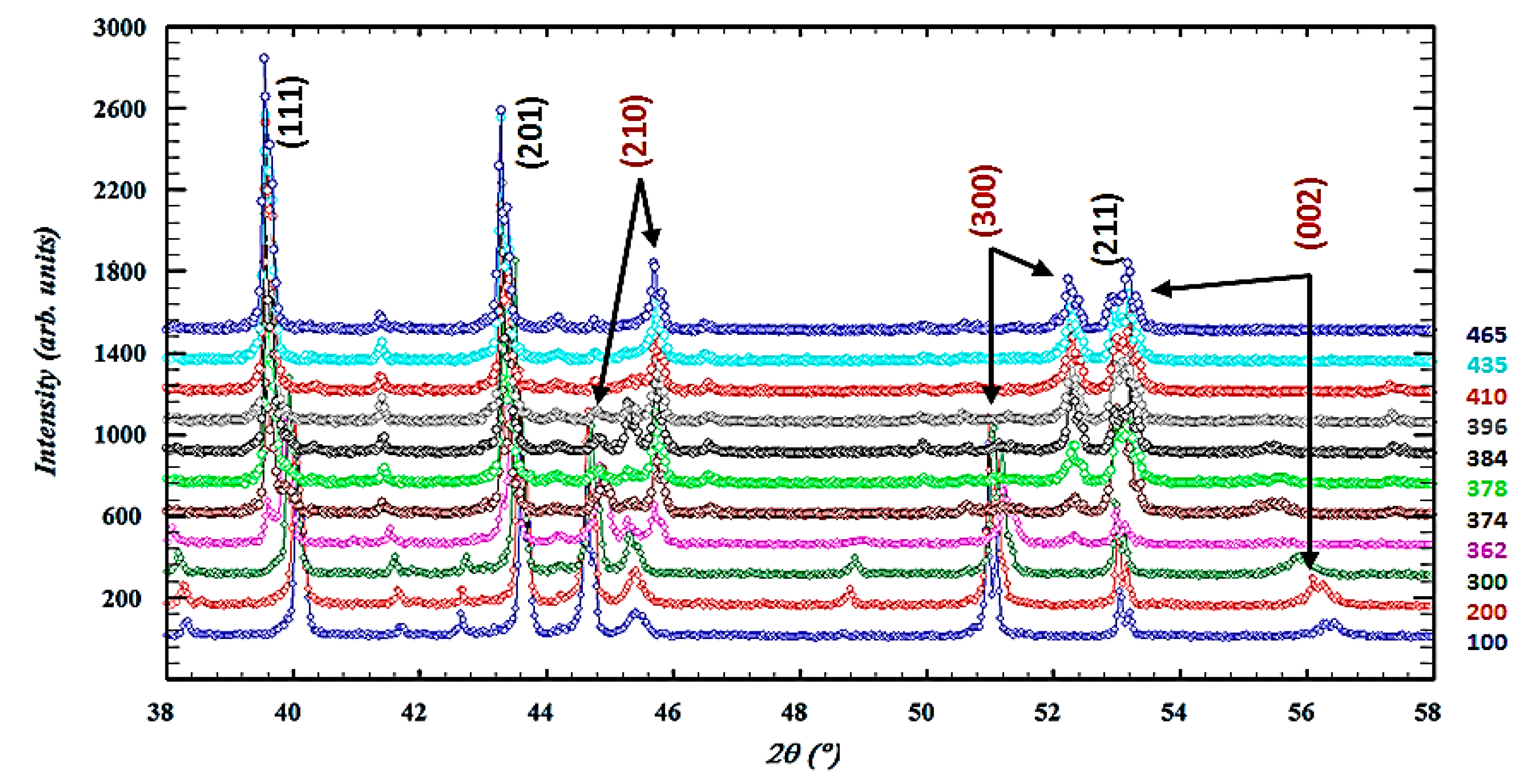
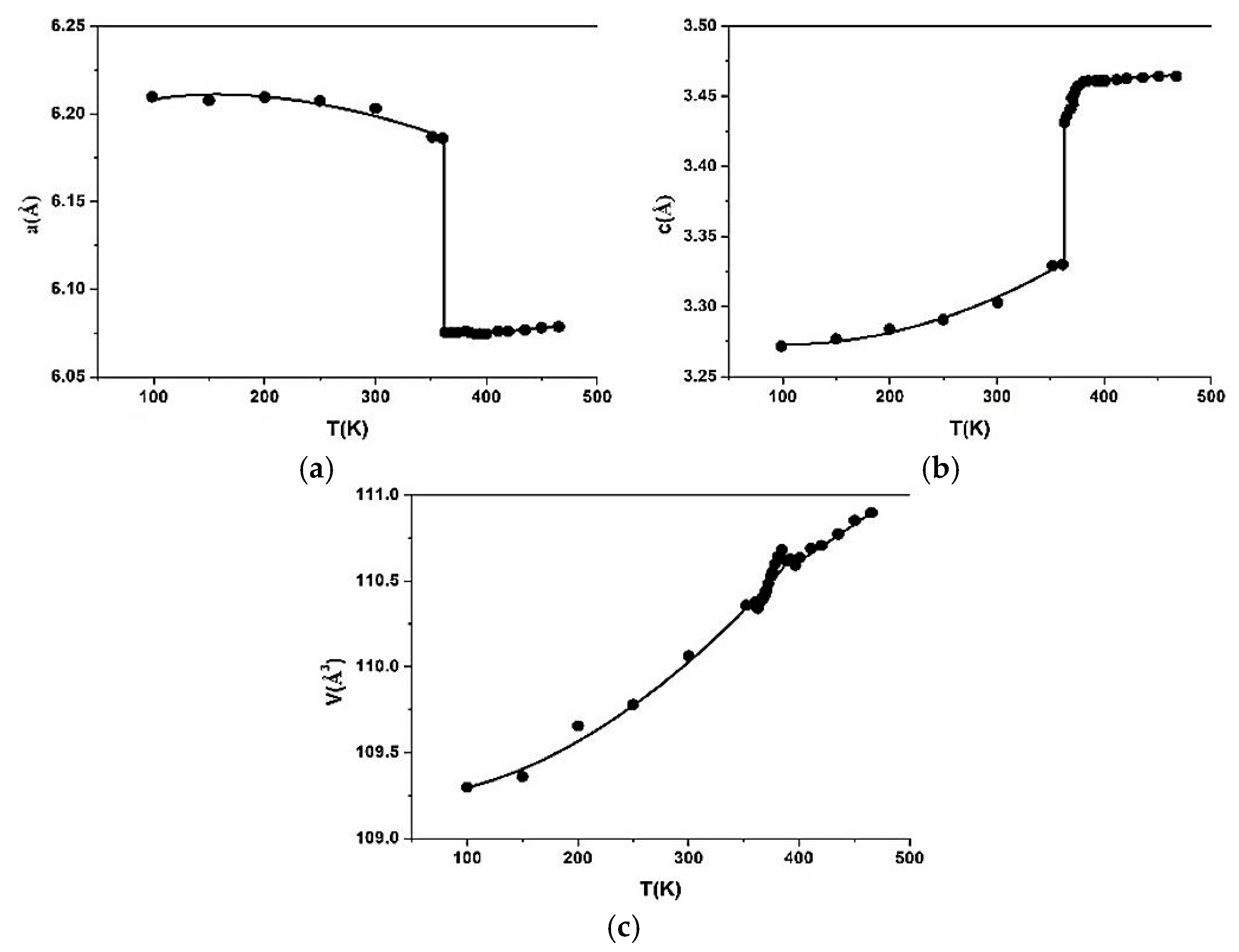
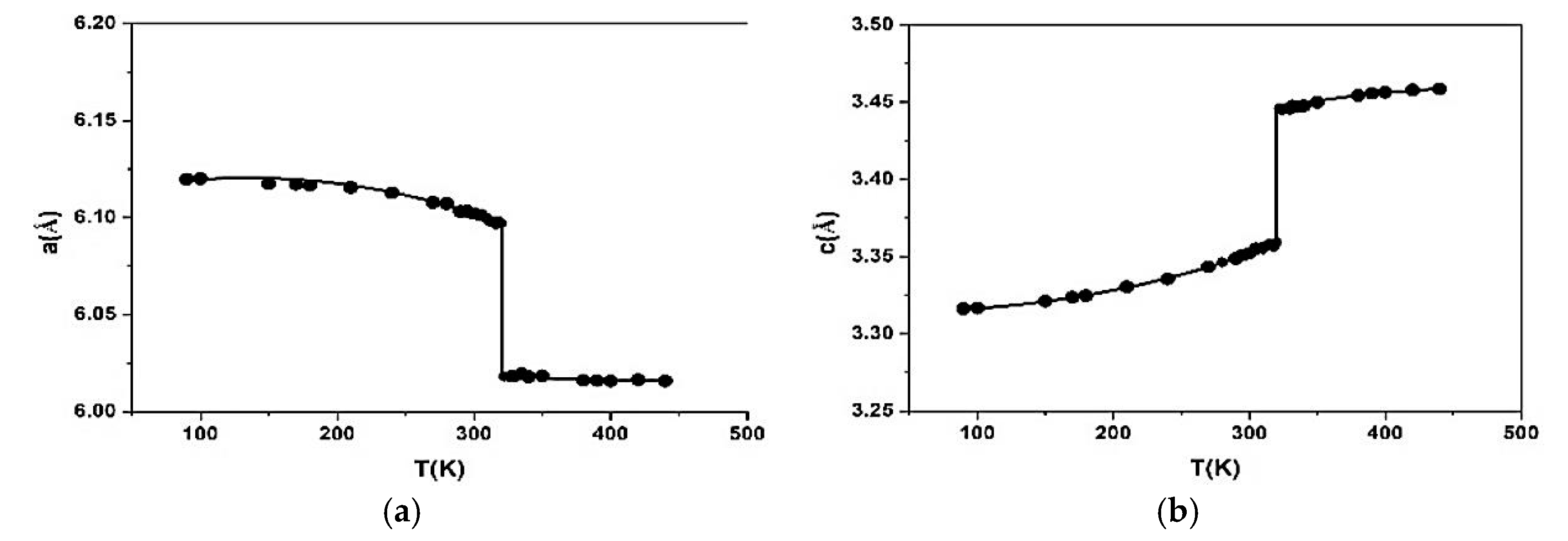
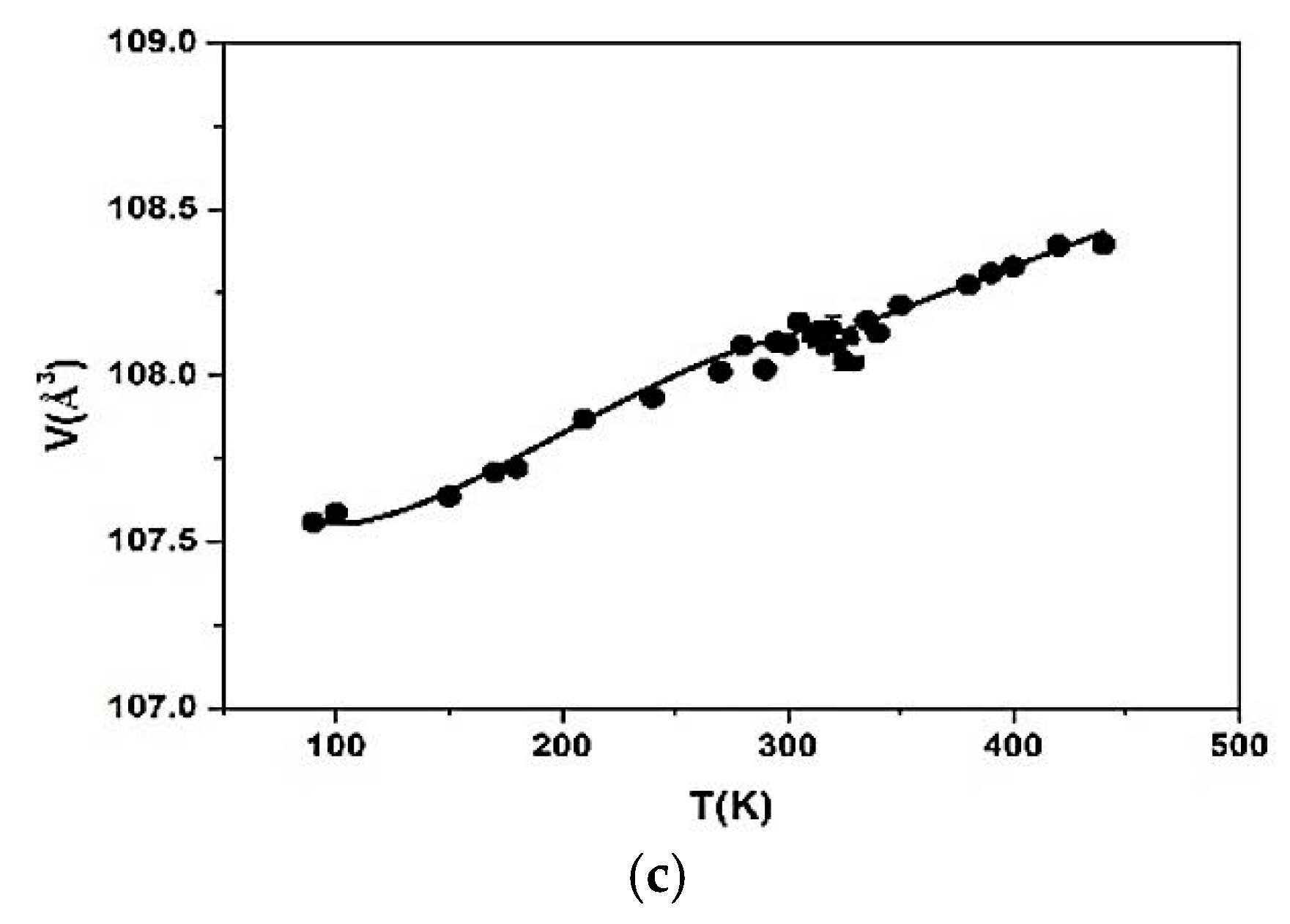
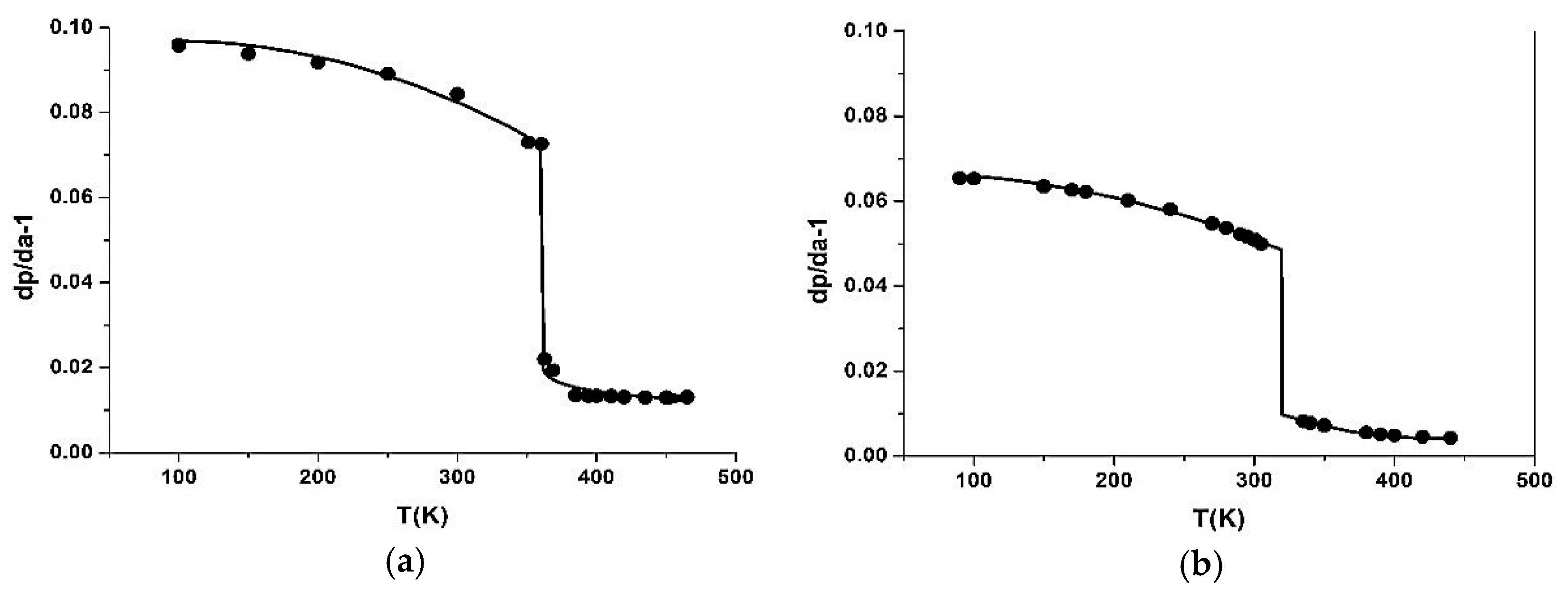
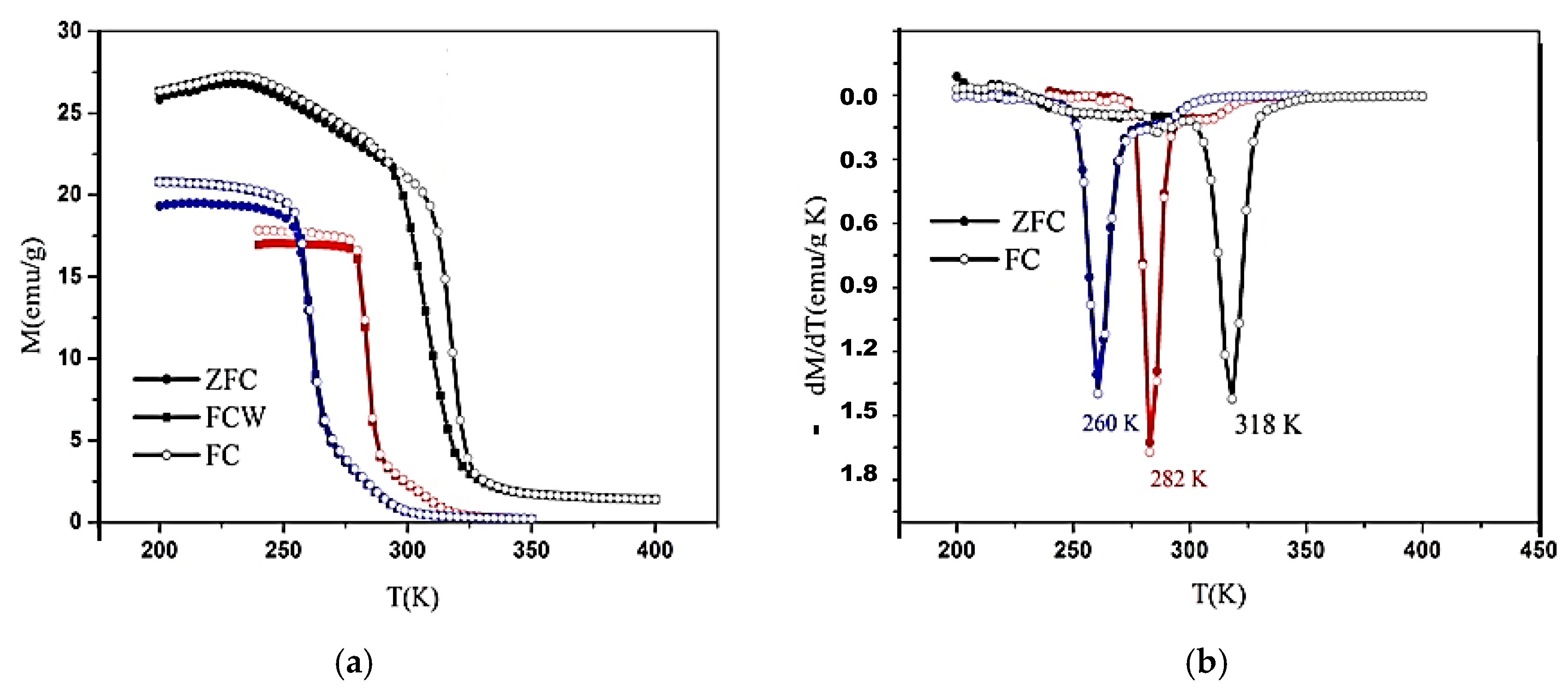
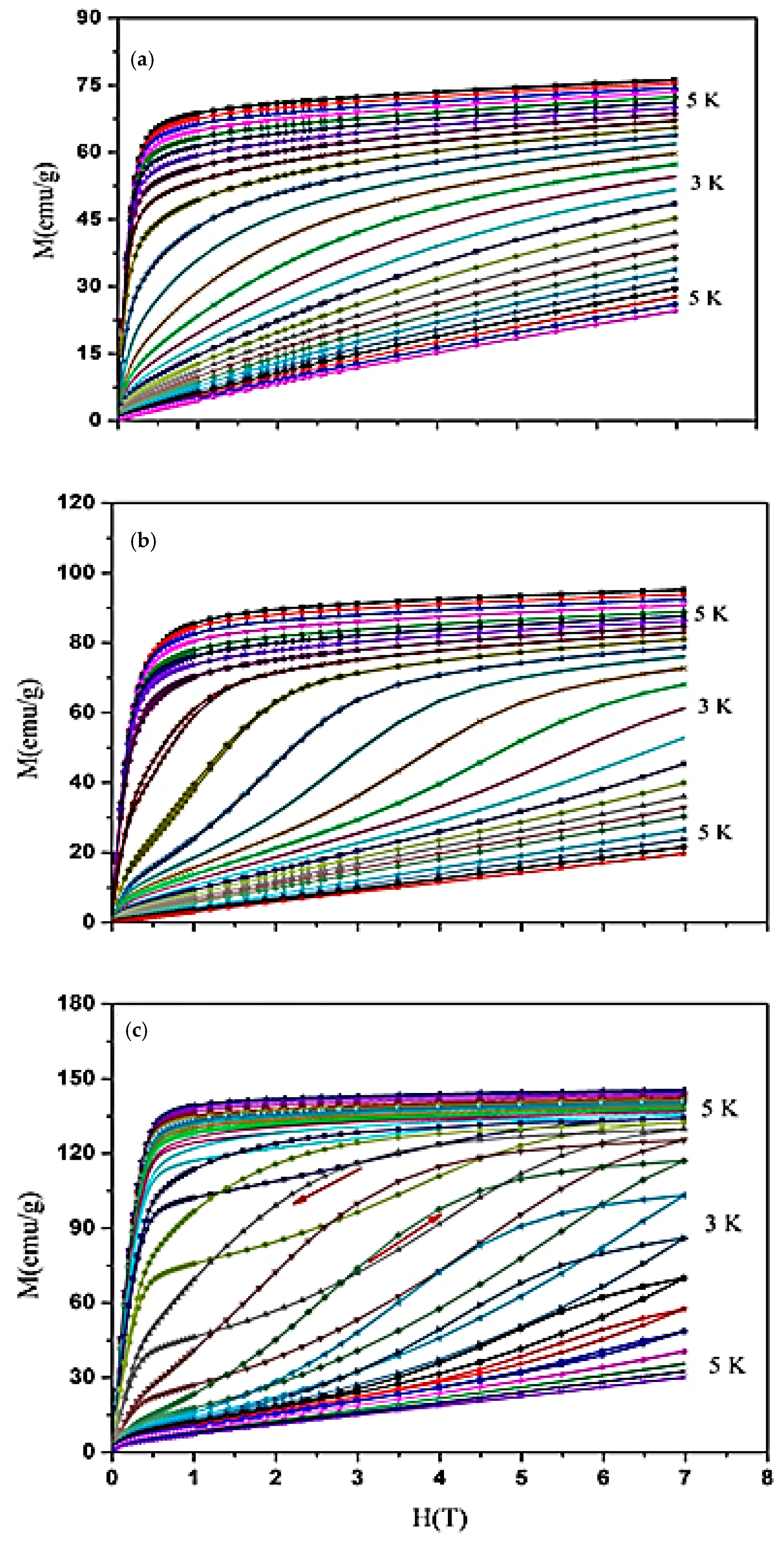
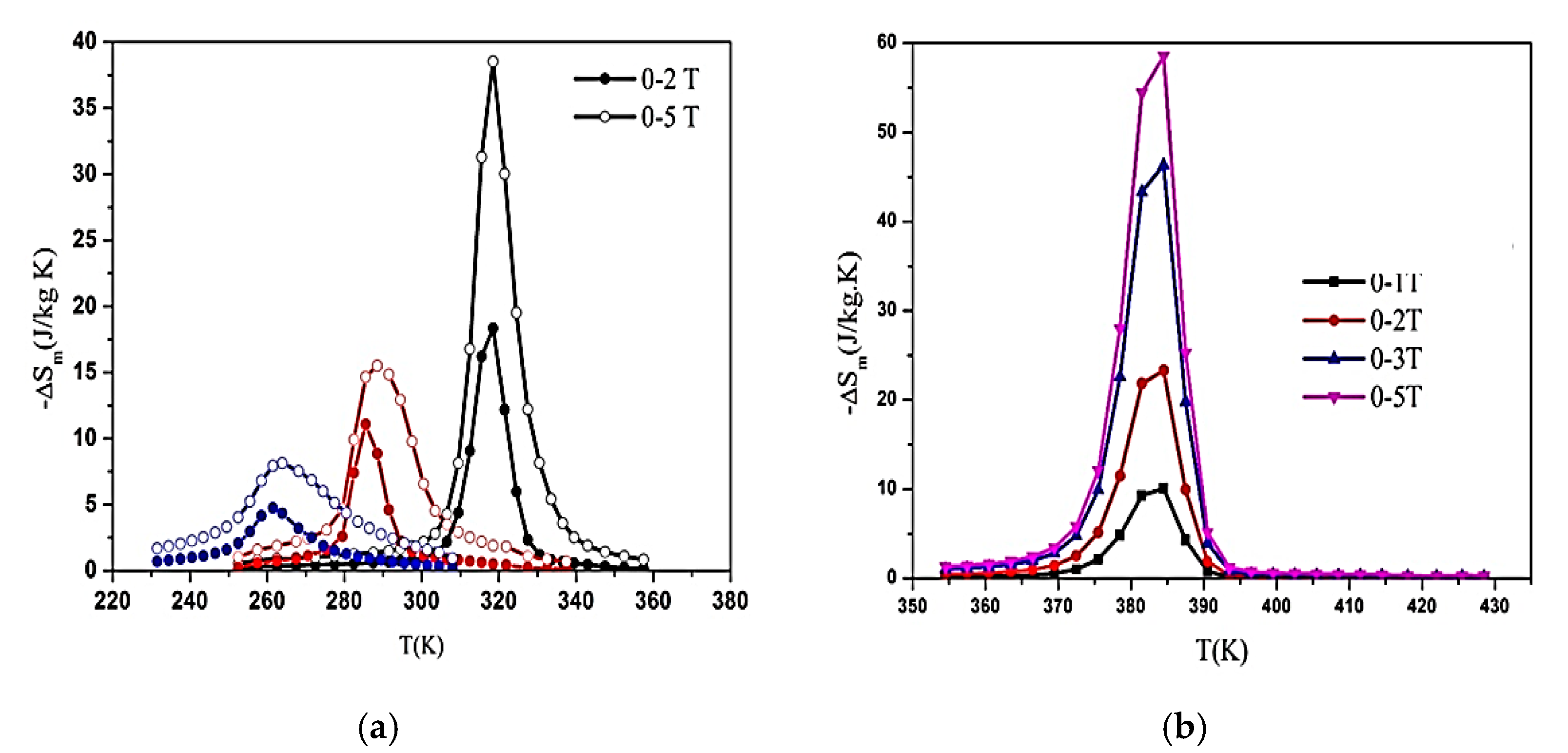
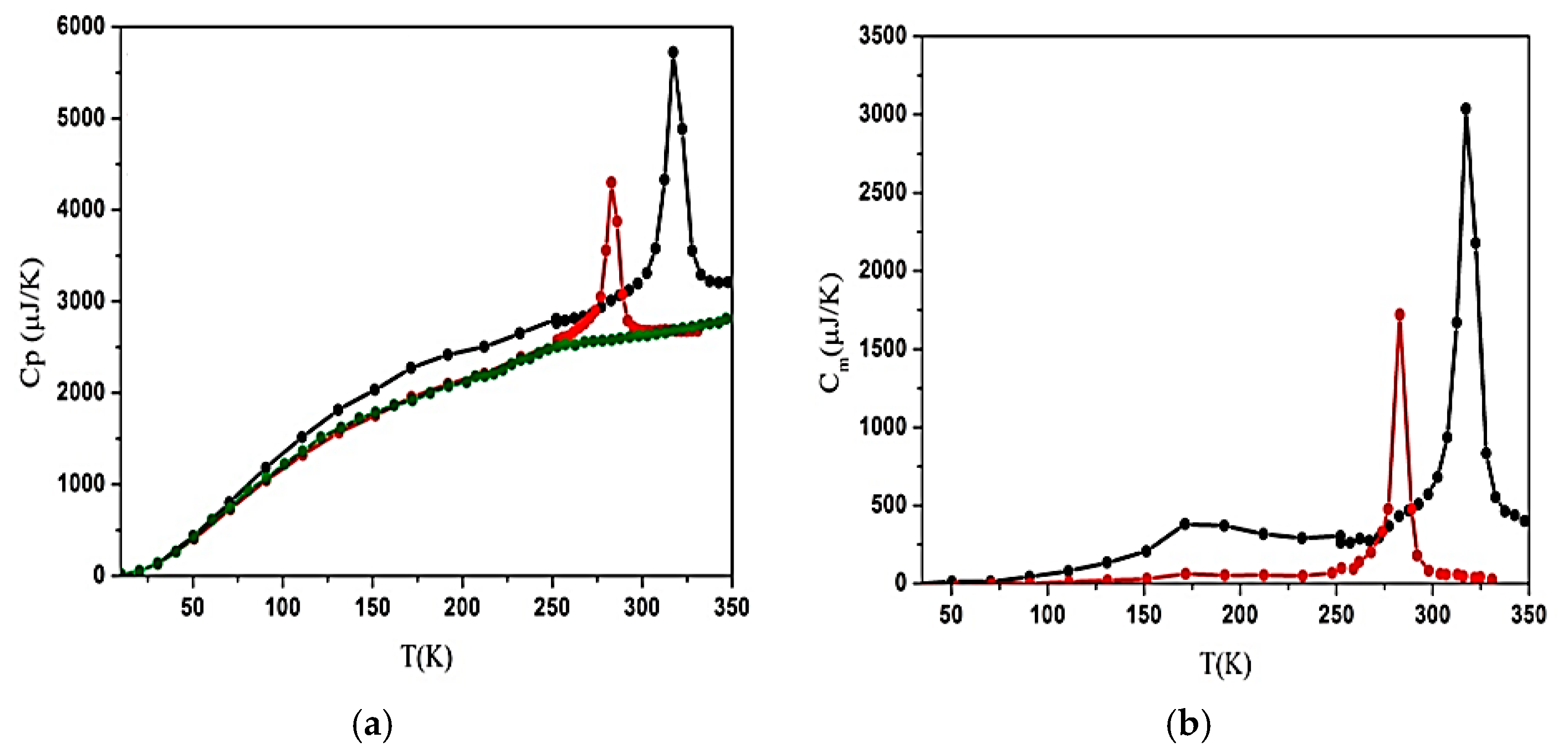
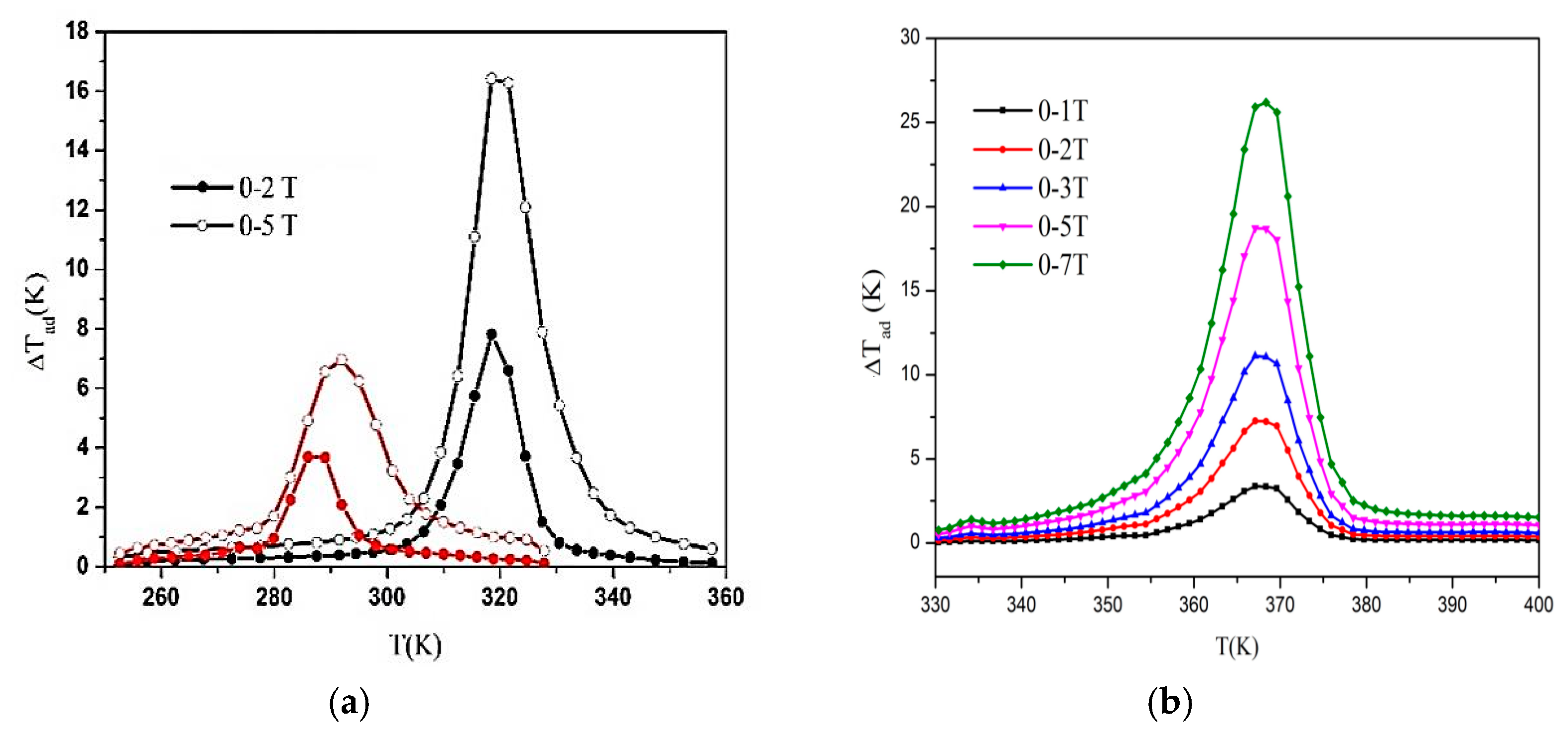
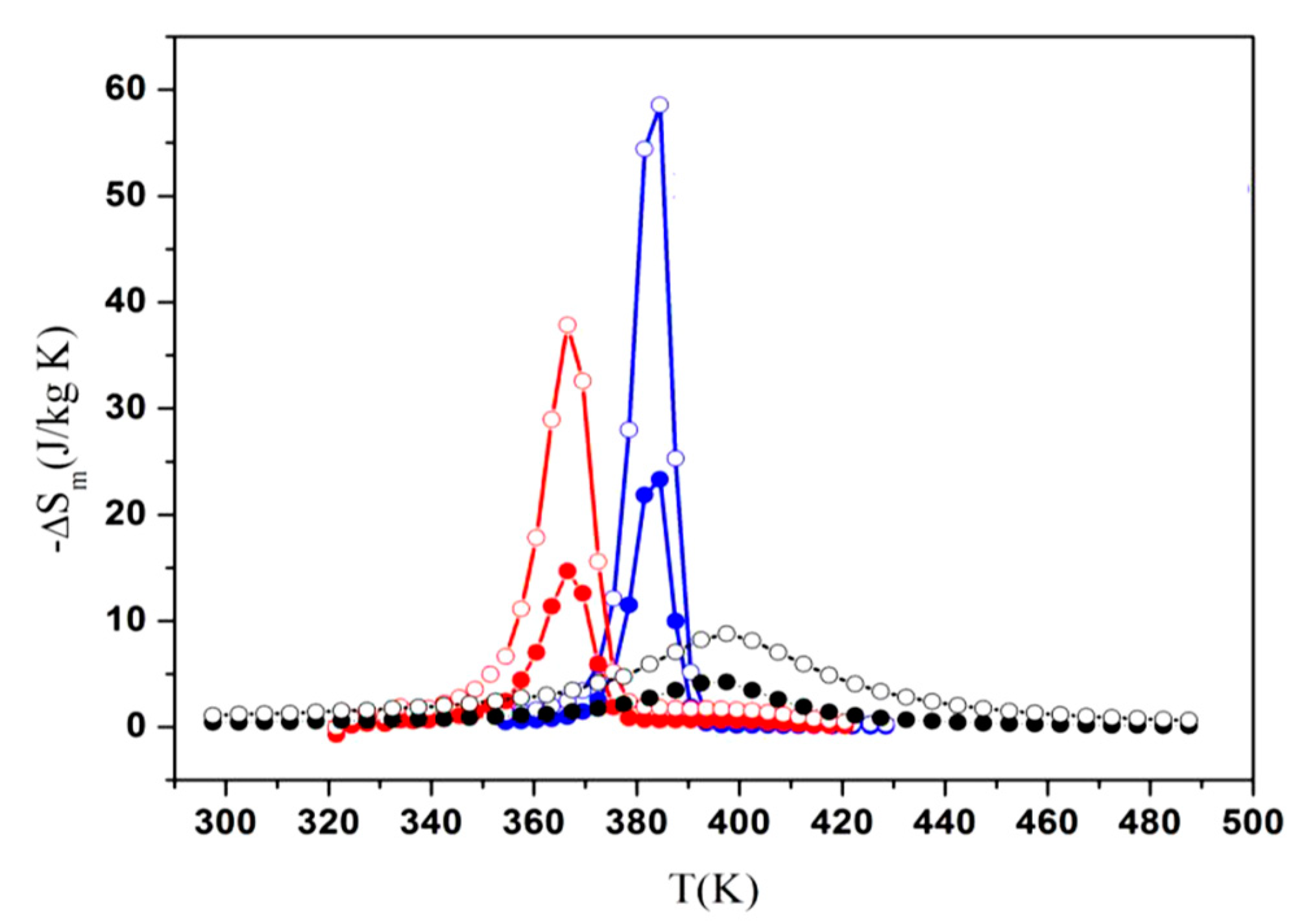
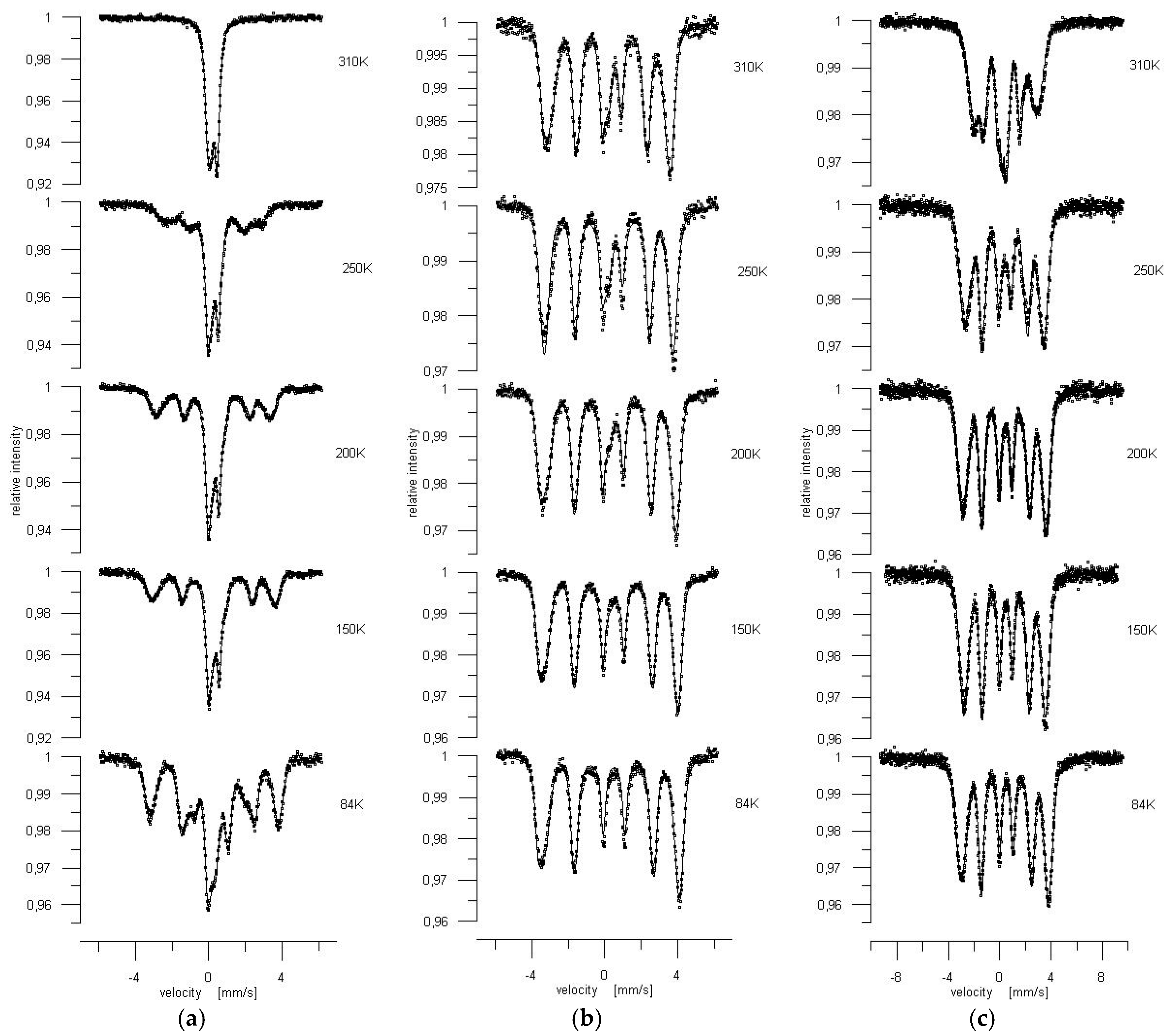
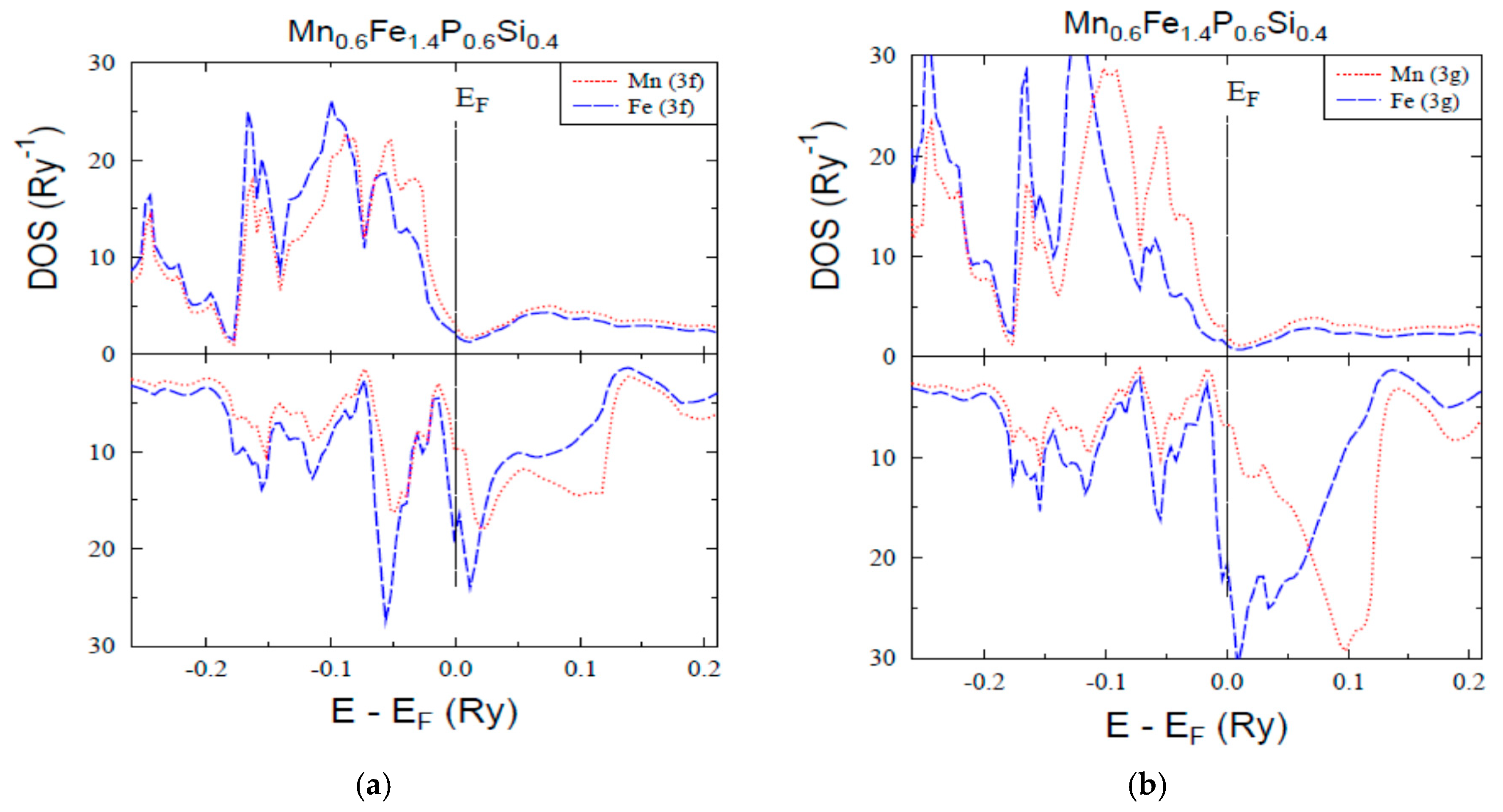
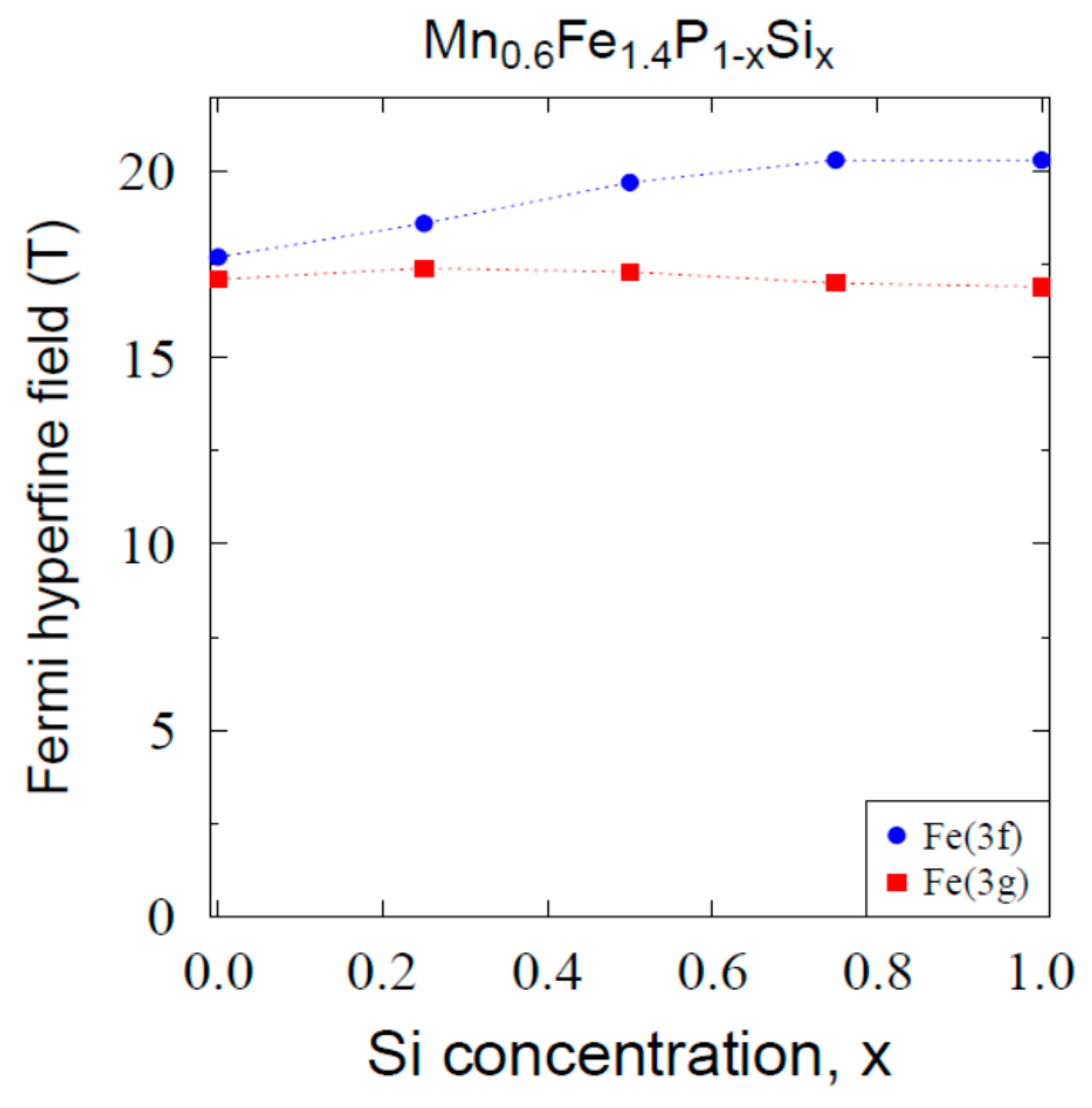
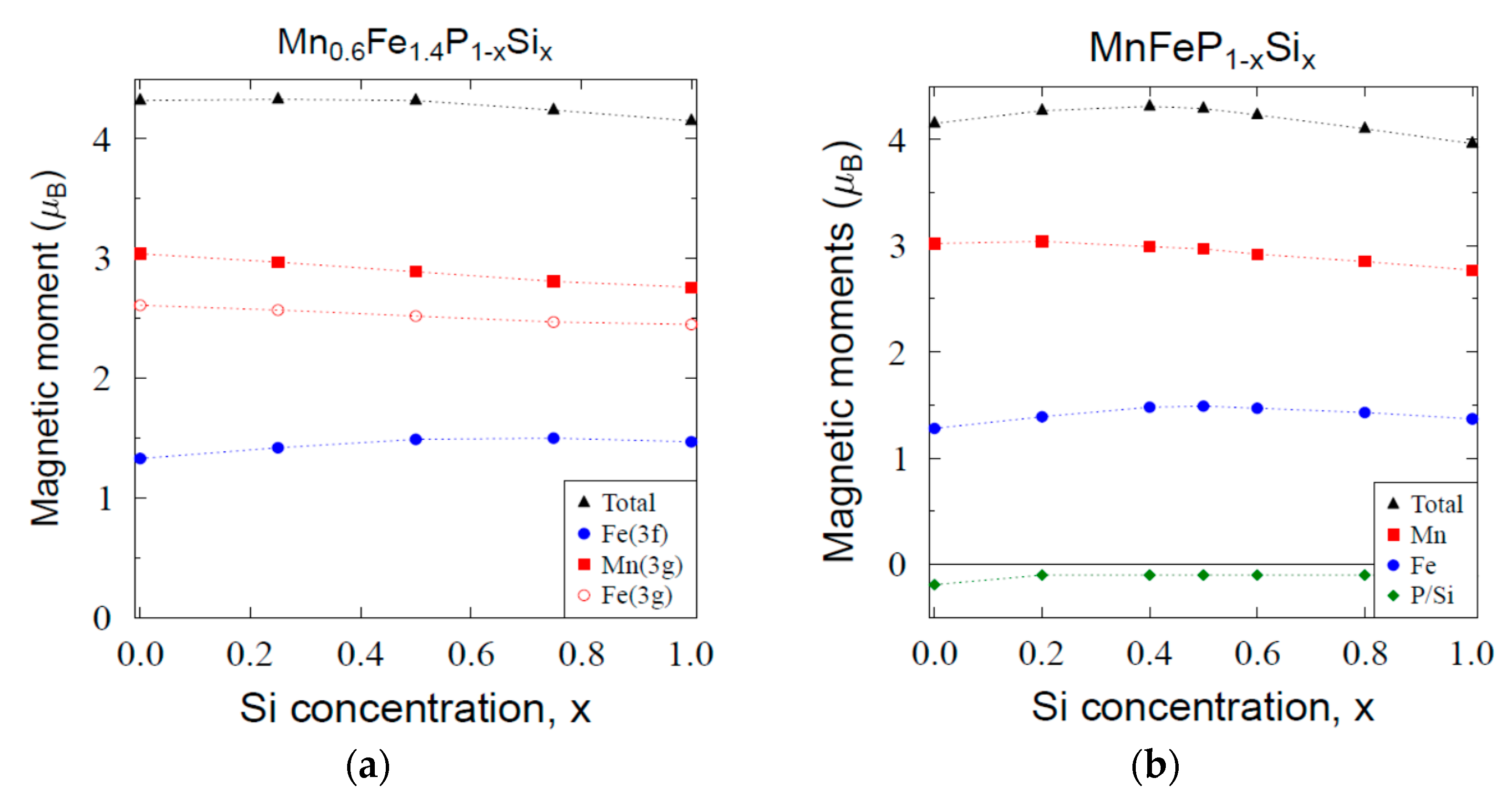
| Sites | Sample I | x | y | z | Sample II | x | y | z |
|---|---|---|---|---|---|---|---|---|
| 3g | 100% Mn | 0.5967(1) | 0.0 | 0.5 | 56% Mn + 44% Fe | 0.598(8) | 0.0 | 0.5 |
| 3f | 100% Fe | 0.2491(2) | 0.0 | 0.0 | 100% Fe | 0.268(6) | 0.0 | 0.0 |
| 2c | P,Si | 0.33333 | 0.66666 | 0.0 | 100% P | 0.33333 | 0.66666 | 0.0 |
| 1b | P,Si | 0.0 | 0.0 | 0.5 | 33.3% P + 66.6% Si | 0.0 | 0.0 | 0.5 |
| Compounds | % Fe2P-Type (P-62m) | % Mn5Si3-Type (P63/mcm) | Cell Parameters (Å) |
|---|---|---|---|
| Mn1.40Fe0.60P0.30Si0.70 | 91 | 9 | a = 6.139, c = 3.425 |
| Mn1.30Fe0.70P0.35Si0.65 | 96 | 4 | a = 6.053, c = 3.355 |
| MnFeP0.50Si0.50 | 96 | ~4% MnFe2Si | a = 6.196, c = 3.309 |
| Mn0.70Fe1.30P0.65Si0.35 | 99 | <1 | a = 6.101, c = 3.347 |
| Mn0.60Fe1.40P0.60Si0.40 | 99 | <1 | a = 6.123, b = 3.334 |
| Compound | Fe/Mn | Si/P | Transition Order | TC (K) | MS (µB) | ∆T hys (K) | −∆Smmax (J/kg K) 2 T–5 T | ∆Tad (K) 2 T–5 T |
|---|---|---|---|---|---|---|---|---|
| Mn1.40Fe0.60P0.30Si0.70 | 2.333 | 2.333 | F→P 1–2nd (?) | 260 | 4.17 | 0 | 4.63–8.3 | - |
| Mn1.30Fe0.70P0.35Si0.65 | 1.858 | 1.858 | MET 1st | 282 | >2.87 | 0 | 11–15.5 | 3.6–6.8 |
| MnFeP0.50Si0.50 * | 1.0 | 1.0 | MET 1st | 365 | 3.95 | 18 | 15–30 | 7.6–20 |
| MnFeP0.50Si0.50 ** | 1.0 | 1.0 | MET 1st | 382 | 3.77 | 18 | 24–58 | 8–16.1 |
| Mn0.70Fe1.30P0.65Si0.35 | 0.538 | 0.538 | MET 1st | 318 | >3.25 | 10 | 18.4–38 | 7.8–16.4 |
| Mn0.60Fe1.40P0.60Si0.4 | 0.428 | 0.666 | F→P 1–2nd (?) | 394 | 4.05 | 6 | 4.1–8.5 | 1.1–2.5 |
| T | <B> | σ | IS | QS | P | <B> | σ | IS | QS | P | <B> | σ | IS | QS | P |
|---|---|---|---|---|---|---|---|---|---|---|---|---|---|---|---|
| 310 | 0 0 0 | 0 0 0 | 0.23 0.20 0.17 | 0.41 0.59 0 | 49 11 40 | 21.6 0 19.5 | 2.3 0 2.8 | 0.28 0.19 0.32 | −0.22 0 −0.13 | 49 11 40 | 16.2 13.9 0 | 3.3 3.6 0 | 0.29 0.36 0.28 | 0.25 0.23 0.30 | 64 18 18 |
| 250 | 15.6 0 0 | 4.0 0 0 | 0.29 0.24 0.17 | −0.18 0.58 0 | 50 10 40 | 22.6 0 20.8 | 2.4 0 2.6 | 0.31 0.23 0.37 | −0.22 0 −0.12 | 50 10 40 | 19.3 16.1 0 | 3.0 3.6 0 | 0.37 0.44 0.30 | 0.06 0.1 0.29 | 72 21 7 |
| 200 | 19.1 0 0 | 3.3 0 0 | 0.33 0.29 0.19 | −0.19 0.59 0 | 40 7 53 | 23.3 0 21.5 | 2.1 0 2.5 | 0.34 0.23 0.39 | −0.23 0 −0.14 | 40 7 53 | 20.3 18.7 | 2.9 2.7 | 0.40 0.47 | 0.15 0.10 | 77 23 |
| 150 | 20.6 0 0 | 3.0 0 0 | 0.36 0.29 0.19 | −0.19 0.59 0 | 43 10 47 | 23.8 0 21.9 | 2.1 0 2.5 | 0.37 0.29 0.42 | −0.23 0 −0.14 | 43 10 47 | 19.9 18.6 | 2.8 2.5 | 0.41 0.48 | 0.14 0.07 | 77 23 |
| 84 | 21.6 9.5 1.9 | 2.7 3.2 2.5 | 0.40 0.31 0.21 | −0.21 0.25 0.07 | 45 55 | 24.2 22.4 | 2.0 2.6 | 0.39 0.44 | −0.24 −0.14 | 45 55 | 21.3 19.5 | 2.9 2.6 | 0.45 0.52 | −0.15 0.07 | 77 23 |
| Compound | VEC | Total (cal.) | Mn3f | Fe3f | Mn3g | Fe3g | Magn. (exp.) |
|---|---|---|---|---|---|---|---|
| Mn1.4Fe0.6P0.3Si0.7 | 19.0 | 4.25 | 1.76 | 1.48 | 2.82 | - | 4.17 |
| Mn1.3Fe0.7P0.35Si0.65 | 19.05 | 3.98 | 1.48 | 1.40 | 2.69 | - | >2.85 * |
| MnFeP0.5Si0.5 | 19.5 | 4.30 | - | 1.49 | 2.97 | - | 3.77–3.95 |
| Mn0.7Fe1.3P0.65Si0.35 | 19.95 | 4.04 | - | 1.41 | 2.92 | 2.44 | >3.25 * |
| Mn0.6Fe1.4P0.6Si0.4 | 20.0 | 3.99 | - | 1.43 | 2.91 | 2.42 | 4.05 |
| Compound | VEC | Total (cal.) | Mn3f | Fe3f | Mn3g | Fe3g | Magn. (exp.) |
|---|---|---|---|---|---|---|---|
| MnFeAs (HP) [10] | - | >4.23 ** | - | 1.10 | 3.13 | - | 4.50 |
| MnFeP0.5As0.5 | - | >3.80 ** | - | 1.20 | 2.60 | - | 4.13 |
| MnFeP0.7As0.3 [14] | - | >4.27 ** | - | 1.25 | 3.02 | - | 4.10 |
© 2019 by the authors. Licensee MDPI, Basel, Switzerland. This article is an open access article distributed under the terms and conditions of the Creative Commons Attribution (CC BY) license (http://creativecommons.org/licenses/by/4.0/).
Share and Cite
Fruchart, D.; Haj-Khlifa, S.; de Rango, P.; Balli, M.; Zach, R.; Chajec, W.; Fornal, P.; Stanek, J.; Kaprzyk, S.; Tobola, J. Structure and Magnetic Properties of Bulk Synthesized Mn2−xFexP1−ySiy Compounds from Magnetization, 57Fe Mössbauer Spectroscopy, and Electronic Structure Calculations. Crystals 2019, 9, 37. https://doi.org/10.3390/cryst9010037
Fruchart D, Haj-Khlifa S, de Rango P, Balli M, Zach R, Chajec W, Fornal P, Stanek J, Kaprzyk S, Tobola J. Structure and Magnetic Properties of Bulk Synthesized Mn2−xFexP1−ySiy Compounds from Magnetization, 57Fe Mössbauer Spectroscopy, and Electronic Structure Calculations. Crystals. 2019; 9(1):37. https://doi.org/10.3390/cryst9010037
Chicago/Turabian StyleFruchart, Daniel, Sonia Haj-Khlifa, Patricia de Rango, Mohamed Balli, Ryszard Zach, Wieslaw Chajec, Piotr Fornal, Jan Stanek, Stanislaw Kaprzyk, and Janusz Tobola. 2019. "Structure and Magnetic Properties of Bulk Synthesized Mn2−xFexP1−ySiy Compounds from Magnetization, 57Fe Mössbauer Spectroscopy, and Electronic Structure Calculations" Crystals 9, no. 1: 37. https://doi.org/10.3390/cryst9010037
APA StyleFruchart, D., Haj-Khlifa, S., de Rango, P., Balli, M., Zach, R., Chajec, W., Fornal, P., Stanek, J., Kaprzyk, S., & Tobola, J. (2019). Structure and Magnetic Properties of Bulk Synthesized Mn2−xFexP1−ySiy Compounds from Magnetization, 57Fe Mössbauer Spectroscopy, and Electronic Structure Calculations. Crystals, 9(1), 37. https://doi.org/10.3390/cryst9010037







